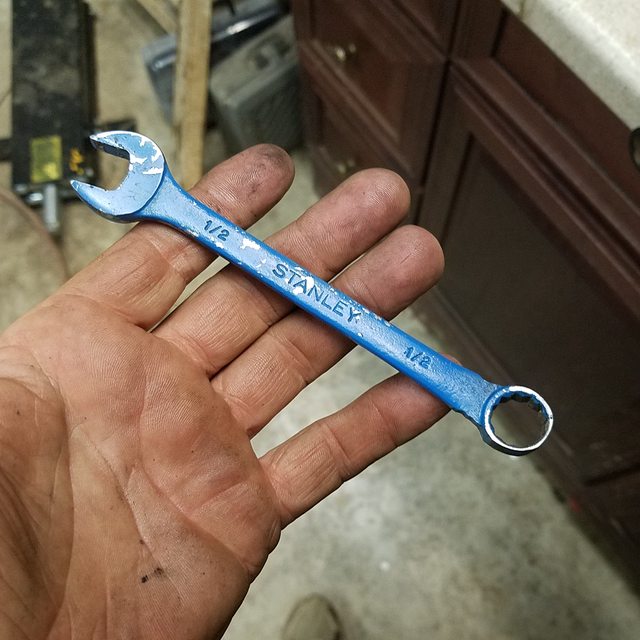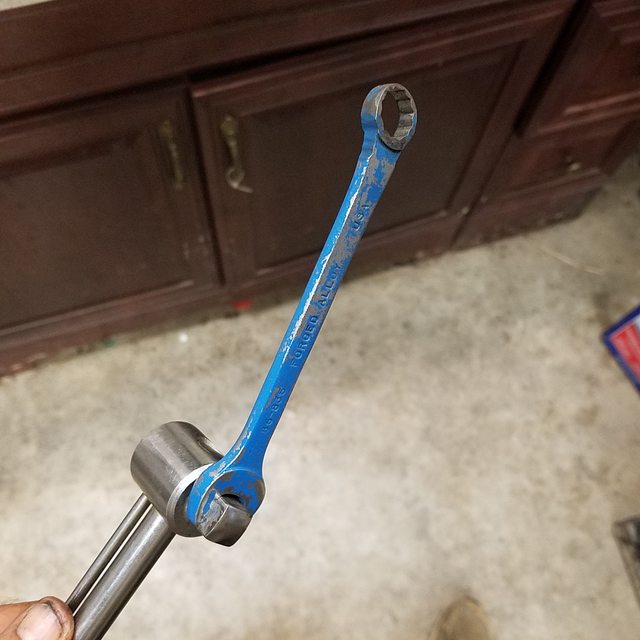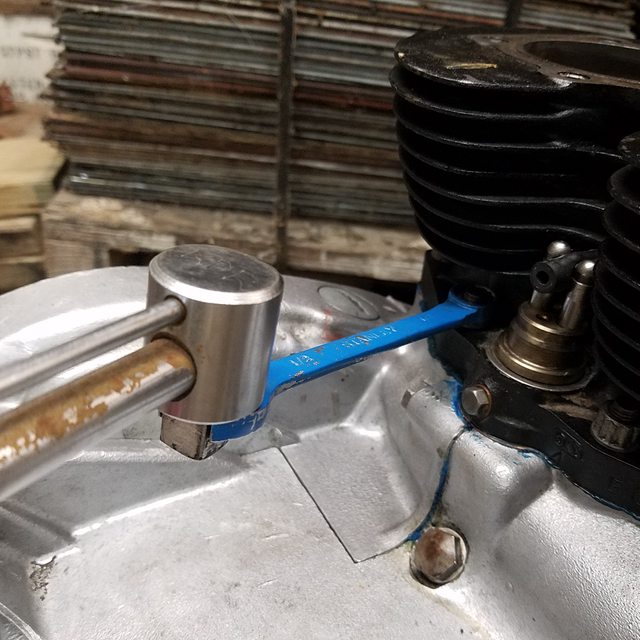Harbor Freight is your friend. Even if you only buy a big socket and a big breaker bar.I don't have an impact gun, so may need to ad lib.
You are using an out of date browser. It may not display this or other websites correctly.
You should upgrade or use an alternative browser.
You should upgrade or use an alternative browser.
1967/1969 Bonnie Rebuild Desert Sled Project

Help Support Triumph Motorcycle Forum:
This site may earn a commission from merchant affiliate
links, including eBay, Amazon, and others.
speedrattle
Well-Known Member
be careful with the clymers manual. it contains a subset of the factory manual procedures and can be confusing.
if someone offers you a haynes manual walk away
if someone offers you a haynes manual walk away
OK, in addition to the Glenns, what do you recommend? This is a 69 engine with a 800cc big bore kit. Thanks.be careful with the clymers manual. it contains a subset of the factory manual procedures and can be confusing.
if someone offers you a haynes manual walk away
I've got the big breaker bar, and I may have the big socket also.Harbor Freight is your friend. Even if you only buy a big socket and a big breaker bar.
speedrattle
Well-Known Member
the factory 1963-1970 manual is the first source floyd clymers book is a condensed version of it, with the exception of the performance chapter, which is pretty rudimentary.OK, in addition to the Glenns, what do you recommend? This is a 69 engine with a 800cc big bore kit. Thanks.
sonny routts kit originally came with somecsort of instruction did you manage to snag any of it? if not, thats okay, as you have something thats already togethrr.
glenns manual is good for post-1970 650s, iirc, and has a decent section on the 5-speed gearbox. my copy is is the shop somewhere. have to look over it again.
Thank you for the information. I've got nothing from Routt, but should look online for this. I will be curious when I get the head and cylinders off to see if it is still going to be ok to use this big bore kit.the factory 1963-1970 manual is the first source floyd clymers book is a condensed version of it, with the exception of the performance chapter, which is pretty rudimentary.
sonny routts kit originally came with somecsort of instruction did you manage to snag any of it? if not, thats okay, as you have something thats already togethrr.
glenns manual is good for post-1970 650s, iirc, and has a decent section on the 5-speed gearbox. my copy is is the shop somewhere. have to look over it again.
I just use 50/50 Simple Green and hot water, with stiff bristle brushes (plastic normally, brass if really baked-on crud).For engine case preparation, is vapor blasting the way to go? Or is a good cleaning and brass brush ok? Appreciate any thoughts on this. Also for parts like wheel hubs, etc.
OK, great. I like this simple approach. Thanks.I just use 50/50 Simple Green and hot water, with stiff bristle brushes (plastic normally, brass if really baked-on crud).
The 1/4" screws that mount the rocker boxes on the head, what thread? 1/4"-20 is UNC is 69 onwards, 1/4"-26 is BSF is pre 69.dating my "1969?" cylinder head. The engine is 1969,
If you mean a cast year with little lines radiating around it for the month, it might become visible when you lift the head off the block.I don't see a date where I thought the date should be
Or, as it is a HDA head, you might see a series of letters and numbers stamped on the head, possibly near the timing side inlet valve?
OK, I'll have to look more closely - and - what is an "HDA" head? Thanks.The 1/4" screws that mount the rocker boxes on the head, what thread? 1/4"-20 is UNC is 69 onwards, 1/4"-26 is BSF is pre 69.
If you mean a cast year with little lines radiating around it for the month, it might become visible when you lift the head off the block.
Or, as it is a HDA head, you might see a series of letters and numbers stamped on the head, possibly near the timing side inlet valve?
One with "HDA" cast on it. Like the one in your photo ..."HDA" head?
Stands for "High Duty Alloys" - one of the outside companies that did castings for Triumph.
Thanks, lot's to learn.One with "HDA" cast on it. Like the one in your photo ...
Stands for "High Duty Alloys" - one of the outside companies that did castings for Triumph.
Looks like you date mark is very faint - looking at the photo, on the right side hollow between the valve pockets should be a circular cast (raised) mark with several tick marks, and a 2-digit year code. The tick marks represent the month. The year would show that it was cast UP TO a year before it was installed on the assembly line.I'd appreciate any comments on dating my "1969?" cylinder head. The engine is 1969, cylinder a Routt big bore - but I don't see a date where I thought the date should be on the head - see photo.
So I was chagrined when I came to take the cylinder off tonight, thinking I had the correct tools. But I did not have 12 point Whitworth wrenches, only the 12 point sockets. Plus, it almost looks like I would need very thin 12 point Whitworth wrenches as the clearance is quite small. The clearance on this cylinder seems much less than others I've seen in photos. Perhaps because it is the 800cc big bore cylinder it messes with the clearance?
A couple of other interesting finds - when removing the push rods, one of the rods on the exhaust side came out looking a lot different than the others - very dark and the tip on the bottom side dropped off the rod on its own. The dark rod also had some gouging on it that must have been done to it before it was installed. With some of the things I am seeing, loose and mismatched fasteners, it seems this was not assembled properly the last time or perhaps it just got messed with.
The pistons and chamber are all loaded with carbon. The pistons seem to be highly domed also.
With regard to the head, the place where the date is supposed to be cast in has the oval, but there is nothing in the oval. I have heard that this may be due to is being a replacement head? There is another marking stamped or cast into the head, it reads "23 - D".
So that's it for now. I will have to find some proper Whitworth wrenches to remove the cylinder.
Thanks for any advice, comments, etc.









A couple of other interesting finds - when removing the push rods, one of the rods on the exhaust side came out looking a lot different than the others - very dark and the tip on the bottom side dropped off the rod on its own. The dark rod also had some gouging on it that must have been done to it before it was installed. With some of the things I am seeing, loose and mismatched fasteners, it seems this was not assembled properly the last time or perhaps it just got messed with.
The pistons and chamber are all loaded with carbon. The pistons seem to be highly domed also.
With regard to the head, the place where the date is supposed to be cast in has the oval, but there is nothing in the oval. I have heard that this may be due to is being a replacement head? There is another marking stamped or cast into the head, it reads "23 - D".
So that's it for now. I will have to find some proper Whitworth wrenches to remove the cylinder.
Thanks for any advice, comments, etc.
speedrattle
Well-Known Member
cant remember exactly when triumph went from british standard to unified threads. mid 69? or not until 70? were the 12-point base nuts ever anything but UNF?
if those base nuts are UNF, go buy a cheap half-inch 12-point combination wrench somewhere and then grind or file the box end down until it drops over the nut.
you can fit a half-inch torque wrench into the open end of the wrench when you put it back together and calculate the reduced figure to use to correctly torque the cylinders back on.
if those base nuts are UNF, go buy a cheap half-inch 12-point combination wrench somewhere and then grind or file the box end down until it drops over the nut.
you can fit a half-inch torque wrench into the open end of the wrench when you put it back together and calculate the reduced figure to use to correctly torque the cylinders back on.
You would be even more chagrined if you bought "12 point Whitworth wrenches" ... as the nuts are UNF thread, 1/2" AF for the 3/8"UNF, 7/16" AF for the 5/16"UNF.correct tools. But I did not have 12 point Whitworth wrenches,
Plus you "need very thin 12 point" AF wrenches. While there might be other "thin" wrenches that will not break when you pull hard on them when loosening or tightening the nuts, you might want to consider Snap-On. Not cheap but (should be) no quibble replacement if you do break one.
However, if you will be concerned about correct torque when reassembling, if you buy just a plain wrench with 7/16" AF at one end and 1/2" AF at the other, when reassembling you will need to cobble up something like a fish-weighing scale hooked into the other ring combined with calculating the necessary pull on the scale based on the length of the wrench.
Otoh, certainly Snap-On offer tools with the 12 point ring at one end and a square drive hole at the other end for connecting to a torque wrench. If you have Magpie Syndrome, a Snap-On van is particularly dangerous for your bank balance ...
Regrettably nonsense. When the head was cast, how would the caster know it was going to be a "replacement"?the place where the date is supposed to be cast in has the oval, but there is nothing in the oval. I have heard that this may be due to is being a replacement head?
From information posted on A.N.Other forum, at some point HDA was acquired by a British aircraft maker (Hawker-Siddley?). Primary reason for this was several makers had experienced aircraft crashes, some regrettably with loss of life, subsequent investigations identifying casting errors in one or more critical components (e.g. main wing spars ...) as causes.
When the aircraft maker acquired HDA, Triumph was already one of HDA's customers, HDA continued to cast for Triumph for many years.
It is stamped because it is indented into the casting; "cast" would be raised, like the "H.D.A." and the part number.There is another marking stamped or cast into the head, it reads "23 - D".
Better would be find some proper AF wrenches to remove the cylinder ...?have to find some proper Whitworth wrenches to remove the cylinder.
The UNF/UNC barrel base studs (UNC into the crankcase) and 12 point nuts first appear in the 69 twins parts books. However, aiui they were actually first fitted to bikes made in late (May or June?) 68 production (along with other "69" parts like the 6-3/4" centres fork yokes); iirc there's a 'from' engine number buried in A.N.Other forum?cant remember exactly when triumph went from british standard to unified threads.
Just to confuse, aiui there have been (a) aftermarket batch(es) of Cycle 12-point nuts ...were the 12-point base nuts ever anything but UNF?
Given the state of the fasteners in your images, the ground/filed box end could well break unless the nuts loosen easily.if those base nuts are UNF, go buy a cheap half-inch 12-point combination wrench somewhere and then grind or file the box end down until it drops over the nut.
When you grind the outside of a box wrench for clearance, you can no longer use it in "shock" mode (whacking it with the palm of your hand or ANY hard object).
You must use a steady pull 'till in frees off the fastener (hopefully), or breaks (possibly).
Shock mode just GUARANTEES that it will break.
You must use a steady pull 'till in frees off the fastener (hopefully), or breaks (possibly).
Shock mode just GUARANTEES that it will break.
speedrattle
Well-Known Member
heres one i made

to torque the base nuts i just stick it on the end of a half inch torque wrench


this makes the total torque wrench six inches longer, so i reduce the reading on the wrench proportionally. to get 35 poundsfeet on a cylinder base nut, i think i apply 27 to the wrench, iirc
heres an online formula
https://www.norbar.com/Support/Calculators/Torque-Wrench-Extension-Formula

to torque the base nuts i just stick it on the end of a half inch torque wrench


this makes the total torque wrench six inches longer, so i reduce the reading on the wrench proportionally. to get 35 poundsfeet on a cylinder base nut, i think i apply 27 to the wrench, iirc
heres an online formula
https://www.norbar.com/Support/Calculators/Torque-Wrench-Extension-Formula
Last edited:
Similar threads
- Replies
- 5
- Views
- 29
- Replies
- 0
- Views
- 5
